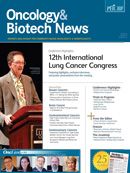Publication
Article
Refining Maintenance Therapy for Multiple Myeloma
Author(s):
The availability of effective novel agents for the treatment of multiple myeloma - including thalidomide, lenalidomide, and bortezomib - has validated the concept of maintenance therapy in myeloma patients.

Steven Devine, MD
The availability of effective novel agents for the treatment of multiple myeloma—including thalidomide, lenalidomide, and bortezomib—has validated the concept of maintenance therapy in myeloma patients. Benefits of maintenance therapy have been reported in both elderly patients and those who have undergone allogeneic stem cell transplantion (allo-SCT).
“With emerging data about new drugs, maintenance therapy for myeloma is a moving target. The question remains, which is the best drug [for maintenance] in which group of patients? The choice of agent should rest on individual patient characteristics, including comorbid conditions and patient preference. Although concern has been raised about second malignancies with lenalidomide and bortezomib as maintenance therapy, this seems to be trumped by reduction in risk of myeloma progression,” stated Steven Devine, MD, professor of Medicine and director of the Blood and Marrow Transplant Program at The Ohio State University Comprehensive Cancer Center in Columbus.
“Maintenance therapy for myeloma is usually of relatively low intensity and long duration,” he said. “Although a number of agents have been studied as maintenance, thalidomide, lenalidomide, and bortezomib have shown benefit.”
These 3 drugs are included in NCCN recommendations, but only thalidomide has level 1 evidence. “We need results of clinical trials for lenalidomide and bortezomib to become level 1. The guidelines do not include recommendations for optimal dose and duration of therapy,” Devine explained.
Thalidomide was the first novel therapy to be studied as maintenance therapy after high-dose chemotherapy and ACST. Four different trials have shown advantages in progression-free survival (PFS) and overall survival for thalidomide maintenance in this setting, but the drug has a high risk of grade 3 and 4 peripheral neuropathy, Devine said.
More recently, lenalidomide versus placebo showed longer time to progression and numerically improved survival as maintenance after allo-SCT in stage I/II myeloma patients under age 70 [McCarthy et al. Blood. 2010;116(suppl abstract 37)].
“This trial showed a survival advantage, and the drug was generally well-tolerated, Devine said. “Hematologic events were the most common side effects, and concern was raised about the potential for second malignancies with lenalidomide. We counsel our patients about this risk and follow them closely.”
Results of a separate trial of lenalidomide versus placebo as maintenance after allo-SCT in patients aged >65 years showed improved PFS, with an increase in grade 3 and 4 side effects and an increase in secondary malignancies (16 with lenalidomide vs 3 with placebo) [Attal et al. Blood. 2010;116(suppl abstract 310)].
“Taken together, evidence from clinical trials suggests that in contrast to thalidomide, lenalidomide maintenance therapy at doses of 5 to 15 mg/day are generally well-tolerated, and the intent should be to use it for at least 1 year,” Devine said.
Data for bortezomib maintenance therapy are not as mature. A recent study compared thalidomide versus bortezomib maintenance therapy [Sonneveld et al. Blood. 2010;116(suppl abstract 40)]. Bortezomib was superior in achieving complete remission with improved tolerability compared with thalidomide. Responses were generally superior in patients with poor-risk cytogenetic abnormalities.
“We need to define more clearly which patients will benefit from lenalidomide and bortezomib maintenance therapy, and we need better tools to monitor for minimal residual disease,” Devine concluded.










